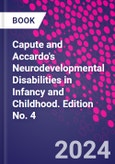Capute and Accardo's Neurodevelopmental Disabilities in Infancy and Childhood, Fourth Edition provides updated foundational, theoretical, and practical knowledge on the spectrum and continuum of neurodevelopmental disabilities shaped by ongoing advances in neuroscience and related disciplines. It reviews the over-arching principles of assessment, diagnosis, and management of patients with a wide range of neurodevelopmental disabilities. Streamlined or fully rewritten chapters, including developmental screening and surveillance, neuroimaging and genetic evaluation, early intervention, principles of pharmacological treatment, principles of successful management programs, aging and transition planning, telemedicine and care in low-resource settings are included.
The book's practical, expert-led approach aims to prepare future clinicians to skillfully assess and manage children with neurodevelopmental disabilities with the aid of clinical approach flowcharts to common presentations, diagnostic algorithms and clinic notes templates.
Please Note: This is an On Demand product, delivery may take up to 11 working days after payment has been received.
Table of Contents
Section 1. Spectrum of Developmental Disabilities1. Definition and conceptualization
2. Typical neurodevelopment
3. What causes NDD?
4. Themes from the neuroscience of NDD
5. Clinical phenotypes of NDD: definition and examples (DSMV or ICD-10)
6. Risk/Screening and Early identification
Section 2. Diagnostic Processes
7. History and physical examination
8. Neurodevelopmental examination (age specific, standardized tools, value of serial evaluations, developmental curves, the 3 Ds: delay, dissociation and deviance)
9. Clinical formulationsi
Section 3. Etiologic Evaluation (indications, advantages, disadvantages, utility, methods, interpretation)
10. Neuroimaging: (Fetal MRI, Head US, brain MRI: structural, functional, metabolic, connectomics)
11. Genetic evaluation (karyotyping, SNP and next generation sequencing)
12. Electrophysiology
13. Neuropsychology and education
14. PT/OT
15. Speech and Language
16. Vision and hearing evaluation
17. Family functioning / social
18. Continuum of NDD expression comorbidities and differential diagnosis
Section 4. NDD beyond the diagnosis: Management/Therapy
19. Prevention (primary, secondary and tertiary)
20. Early intervention (Utility and Futility)
21. Management vs Therapy: (intensity, duration, success, failure, costs, utility and futility)
22. Specific therapiesi
23. The medical home and interdisciplinary care
24. Community support and advocacy
25. Telemedicine
26. Management/therapy in low resource settings
27. Preparing for the many transitionsi
Section 5. Future Directionsi. Research in NDD
28. Limitations and challenges
29. From observation to intervention








